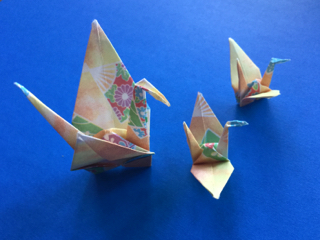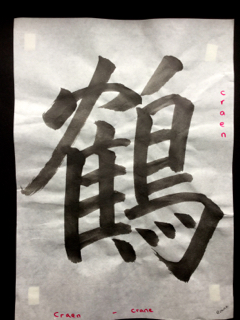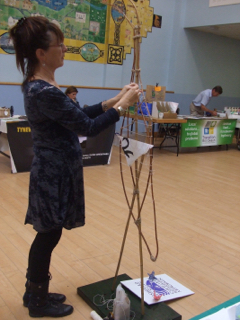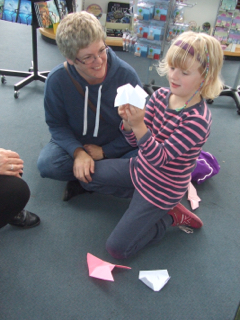 The Origami Crane, Y Craen Origami
The Origami Crane, Y Craen Origami 
Project supported by Pembrokeshie County Council./ Cefnogir y prosiect gan Gyngor Sir Penfro
| The Origami Crane The crane is the most well known origami shape. In Japan it is the symbol for long life and happiness also because of its’ history with Hiroshima it has become a symbol for peace. The story Sadako Sasaki was a Japanese girl who was two years old when an American atomic bomb was dropped on Hiroshima on August 6, 1945, near her home. Ten years later because of the effects of the bomb she was given only a year to live. She heard that if a person could make origami 1000 cranes then they would be granted a wish. Her wish would be eternal world peace. Sadako made 644 cranes before she died. After her death, Sadako's school friends finished making the paper cranes . In 1958, a statue of Sadako holding a golden crane was unveiled in the Hiroshima Peace Memorial Park. This is a symbol of peace for the world |
Y Craen Origami Y craen yw'r siap origami mwyaf adnabyddys . Yn Siapan Mae yn symbol o hapusrwydd a bywyd hir , ac hefyd oherwydd yr hanes yn Hiroshima mae wedi dod yn symbol o heddwch. Y stori. Merch dwy flwydd oed Siapaneaidd oedd Sadako Sasaki pan ollyngwyd bom atomig Americanaidd ar Hiroshima ar Awst 6ed, yn 1945 ger ei chartref. Deng mlynedd yn ddiwedderach oherwydd effaith y bom rhoddwyd ond blwyddyn iddi fyw. Clywodd hi os gallai rhywun wneud 1000 o graeniau origami ,byddai'n cael ei dumuniad. Ei dymuniad hi oedd byd o heddwch tragwyddol . Gwnaeth Sadako 633 craen cyn iddi farw. Ar ol ei marwolaeth gorffennodd ffrindiau ysgol Sadako y creiriau papur. Yn 1958, dadorchuddiwyd cerflun zes o Sadako yn dal craen aur ym Mharc Coffa Heddwch Hiroshima .Symbol o heddwch ar gyfer y byd. |
Artist, Ruth Goodger and willow craft artist, Helen Campbell took part in a fascinating project as part of AKIN while the visiting Japanese artists were here in Pembrokeshire.
   |
      |
| Crane Project Evaluation The workshops were held in the Fishguard Town Hall during the Farmers' Market, the Ocean Lab in Goodwick and finished in Tregwynt Mansion were the decorated crane sculpture was exhibited in the AKIN exhibition which enabled maximum public exposure of the project. The crane was designed and crafted by renowned willow artist Helen Campbell. This 6 foot tall representative structure was then personalised by workshop participants weaving many small triangular shaped papers through it representing its wings. I demonstrated both painting and Shodo techniques for the decoration. Sadako Sasaki was two years old when the nuclear bomb fell on her home town in Japan. When she became ill she started to make thousand paper cranes in the belief that she would be then granted a wish- her wish was for world peace. Although she did not live to complete 1000 her class mates continued her the task on her behalf. This story is relevant on many levels in today’s world where peace seems to becoming increasingly elusive. This young girl’s attempt to make an impact in an adult world resonated with all those who took part in the workshop who were able to carry the quest for resolution of conflict and the search for peace. By engaging in this endeavour children and adults alike tried new artistic methods with different mediums on a variety of surfaces. Some chose to copy the Japanese word for peace, others drew crane feathers and some simply drew smiley faces with their names on. The experience focussed attention on the need for unity and collaboration between nations and between each other. |
